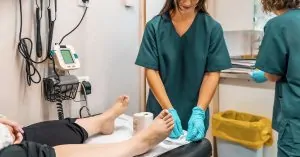Qu'est-ce que le suivi en neurochirurgie : aperçu, avantages et résultats attendus
Headline: The Power of Positive Thinking
Body: Positive thinking is a powerful tool that can help you achieve your goals and live a happier life. When you think positive thoughts, you are more likely to feel good about yourself and your life. You are also more likely to take action and make things happen.
``` Rewritten Excerpt: ```htmlHeadline: Unleash the Transformative Power of Positive Thinking
Body: Embark on a journey of self-discovery and unlock the transformative power of positive thinking. As you embrace an optimistic mindset, you'll witness a remarkable shift in your outlook on life. Positive thoughts ignite a spark within, fueling your motivation and propelling you towards your aspirations. Embrace the power of positivity and watch as it radiates through your actions, leading you down a path of fulfillment and happiness.
``` Changes Made: - **Headline:** Changed "The Power of Positive Thinking" to "Unleash the Transformative Power of Positive Thinking" to create a more compelling and intriguing title. - **Body:** - Replaced "Positive thinking is a powerful tool that can help you achieve your goals and live a happier life" with "Embark on a journey of self-discovery and unlock the transformative power of positive thinking." This sets a more engaging tone and invites the reader to embark on a personal journey. - Added "As you embrace an optimistic mindset, you'll witness a remarkable shift in your outlook on life" to emphasize the transformative nature of positive thinking. - Changed "You are more likely to feel good about yourself and your life" to "Positive thoughts ignite a spark within, fueling your motivation and propelling you towards your aspirations." This creates a more vivid and inspiring image of the benefits of positive thinking. - Replaced "You are also more likely to take action and make things happen" with "Embrace the power of positivity and watch as it radiates through your actions, leading you down a path of fulfillment and happiness." This highlights the tangible impact of positive thinking on one's actions and overall well-beingDéfinition et aperçu
Neurosurgery is the branch of medical science that deals with the prevention, diagnosis and treatment of disorders and diseases affecting the brain, spinal cord and peripheral nerves of the central nervous system. Neurosurgery is also considered an effective rehabilitative procedure for people suffering from degenerative neurological conditions. It is often the final option when conventional methods have less than stellar results.
Any type of surgery, including those performed using minimally invasive techniques, carries certain risks and complications. So it’s extremely vital that neurosurgery follow-ups be strictly followed. This follow-up is a crucial part of post-operative care, which primary goal is to monitor the patient’s recovery and assess the success of the surgical procedure. It is usually scheduled 1 to 2 weeks after surgery to give the patient ample time to rest and recover outside of the hospital. Though a patient is given instructions to follow for his recovery, it is through a follow-up check that any complications (if there are any) can be remedied and treated immediately, preventing them from becoming more serious or life-threatening.
Qui devrait subir et résultats attendus
La neurochirurgie s'adresse aux patients, des enfants aux adultes, qui souffrent de problèmes au cerveau, à la moelle épinière et aux nerfs périphériques. Les personnes ayant subi des interventions chirurgicales pour les affections suivantes sont généralement rappelées pour un suivi en neurochirurgie :
Tumeurs cérébrales, lésion cérébrale et anévrisme cérébral – Ce sont des troubles cérébraux typiques dont le traitement principal est la neurochirurgie. Les tumeurs cérébrales, en particulier les tumeurs malignes, doivent être retirées en particulier si elles empiètent sur la fonction du cerveau. Lorsqu'un coup traumatique à la tête se produit, comme dans le cas d'un accident, le cerveau peut être blessé, entraînant un gonflement et un saignement (hémorragie intracrânienne). Dans un tel cas, un neurochirurgien percera un trou dans le crâne pour libérer le sang. Un anévrisme, en revanche, est un gonflement de la paroi artérielle. Il laisse échapper du sang lorsqu'il se rompt. Lorsqu'un anévrisme est dans le cerveau, il peut provoquer un accident vasculaire cérébral ou la mort. Les neurochirurgiens tentent d'empêcher cela en coupant ou en sceller l'anévrisme pour éviter qu'il ne fuie davantage.
Chirurgie du rachis cervical et du rachis lombaire – Le premier est généralement destiné aux personnes atteintes de discopathie cervicale ou de sténose cervicale, tandis que le second est destiné aux personnes atteintes d'une hernie discale, fracture par tassement lombaire ou sténose lombaire. Ces maladies d'usure affectent la moelle épinière car elles exercent une pression sur les nerfs lorsque les disques de la colonne vertébrale se désalignent, s'usent et s'aplatissent. La neurochirurgie enlève la partie affectée du disque pour relâcher la pression sur le nerf.
Dans certains cas, un suivi neurochirurgical est nécessaire des mois ou des années après l'opération, notamment si le patient prend des médicaments dans le cadre du traitement postopératoire. La prise de médicaments est régulièrement surveillée et peut donc être ajustée ou arrêtée immédiatement en fonction de la progression de la récupération du patient.
De plus, certains patients qui ont subi une neurochirurgie nécessitent un traitement de réadaptation pour surveiller et gérer les effets secondaires. Dans le cas de la chirurgie cérébrale, ceux-ci peuvent inclure des problèmes dans les mouvements, la vision, la parole et d'autres contrôles fonctionnels du patient. Le patient doit suivre une thérapie de rééducation ainsi qu'un suivi neurochirurgical pour suivre ses progrès.
Comment fonctionne la procédure
Le suivi post-opératoire en neurochirurgie est inévitable. Il est généralement prévu 1 à 2 semaines après la chirurgie, où le patient rencontre le médecin à son bureau pour vérifier son rétablissement, surveiller ses signes vitaux et discuter d'une thérapie de réadaptation supplémentaire si nécessaire. C'est là que le médecin effectuera un examen physique pour vérifier les sutures, prescrire ou ajuster les médicaments, surveiller les signes d'infection et donner des instructions concernant l'exercice et le retour à la routine quotidienne.
Un suivi en neurochirurgie peut être initié plus tôt que prévu lorsque le patient éprouve les symptômes suivants après la chirurgie :
- Fuite de liquide de l'incision
- Forte fièvre (supérieure à 101,5)
- Gonflement
- Douleur continue malgré la prise d'analgésiques
Il peut y avoir d'autres symptômes dont le médecin conseillera au patient ou aux membres de la famille de se méfier, comme des hallucinations, des convulsions, des problèmes d'élocution, des picotements dans les bras ou les jambes et des nausées et vomissement.
D'autres traitements de réadaptation nécessitent également un suivi en neurochirurgie pour suivre et surveiller les progrès du patient. Elle peut être programmée trimestriellement ou semestriellement selon le calendrier de traitement du patient. Des examens physiques et des tests diagnostiques peuvent être effectués au cours de ces séances de suivi pour tester la capacité et le contrôle musculaires.
Complications et risques possibles
Des complications peuvent survenir lorsque les signes de danger sur lesquels le médecin a mis en garde ont été ignorés ou négligés. Plus les symptômes sont traités tôt, mieux c'est pour le succès de la chirurgie et le bien-être du patient. Mais s'ils sont ignorés, les problèmes deviendront graves et beaucoup plus difficiles à traiter.
Référence:
- Gasco J, Mohanty A, Hanbali F, Patterson JT. Neurochirurgie. Dans : Townsend CM, Beauchamp RD, Evers BM, Mattox KL, eds. Sabiston Manuel de chirurgie. 19e éd. Philadelphie, Pennsylvanie : Elsevier Saunders ; 2012 : chap. 68.
/trp_language]
[wp_show_posts id=””]**Question: What is Neurosurgery Follow-Up?**
**Answer:** Neurosurgery follow-up refers to the process of monitoring and providing ongoing care to patients who have undergone neurosurgical procedures. It involves regular check-ups, evaluations, and assessments to monitor the patient’s recovery, identify potential complications, and address any ongoing concerns or issues related to the surgery.
**Keywords:** Neurosurgery, Follow-Up, Post-Surgical Care, Monitoring, Evaluation, Assessments.
**Question: What are the Benefits of Neurosurgery Follow-Up?**
**Answer:** Neurosurgery follow-up offers numerous benefits to patients, including:
* **Early Detection of Complications:** Regular follow-up allows healthcare providers to identify and address any potential complications or adverse effects of the surgery promptly, leading to better outcomes.
* **Ongoing Symptom Management:** Follow-up visits enable the management of ongoing symptoms related to the underlying condition or the surgical intervention, ensuring the patient’s overall well-being.
* **Assessment of Recovery Progress:** Follow-ups help evaluate the patient’s progress in terms of recovery, functional abilities, and neurological status, guiding further treatment or rehabilitation strategies.
* **Medication Adjustments:** Neurosurgeons can adjust medications, such as pain relievers or anticonvulsants, based on the patient’s response and changing needs during the recovery process.
* **Patient Education and Support:** Follow-up visits provide an opportunity for the neurosurgeon and other healthcare providers to educate patients about their condition, recovery expectations, and provide emotional support throughout the healing journey.
**Keywords:** Benefits, Early Detection, Ongoing Symptom Management, Recovery Progress Assessment, Medication Adjustments, Patient Education, Emotional Support.
**Question: What Expected Results Can Patients Anticipate During Neurosurgery Follow-Up?**
**Answer:** During neurosurgery follow-up, patients can expect:
* **Comprehensive Evaluation:** Each follow-up visit involves a thorough evaluation to assess the patient’s overall health status, neurological functions, and any persisting symptoms.
* **Imaging Tests:** Depending on the specific neurosurgical procedure, imaging tests such as MRI or CT scans may be conducted to evaluate healing and any changes in the affected area of the brain or spine.
* **Neurological Examination:** The neurosurgeon or a neurologist performs a neurological examination to assess the patient’s reflexes, motor skills, sensory functions, and cognitive abilities.
* **Discussion of Symptoms:** Patients have the opportunity to discuss any new or ongoing symptoms they are experiencing, allowing healthcare providers to address these concerns appropriately.
* **Medication Review:** The neurosurgeon reviews the patient’s current medications, adjusts dosages if necessary, and provides instructions for usage and potential side effects.
* **Recommendations for Rehabilitation:** If needed, the neurosurgeon may recommend physical therapy, occupational therapy, or other rehabilitation interventions to aid in the recovery process.
**Keywords:** Comprehensive Evaluation, Imaging Tests, Neurological Examination, Symptom Discussion, Medication Review, Rehabilitation Recommendations.








Definitive guide to neurosurgical follow-ups covering post-treatment care, prognosis, and possible complications.
Comprehensive guide to neurosurgical follow-up encompassing comprehensive care, prognosis evaluation, and potential complications.